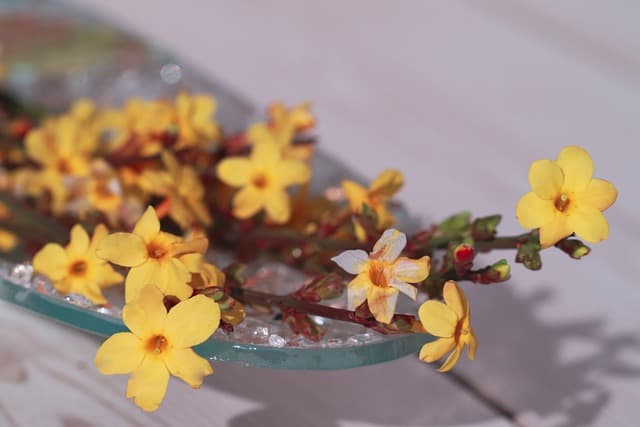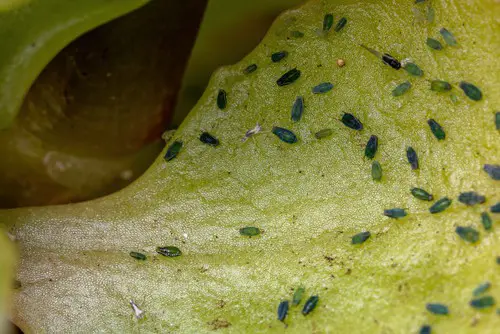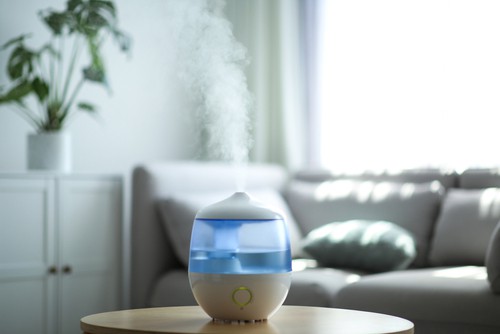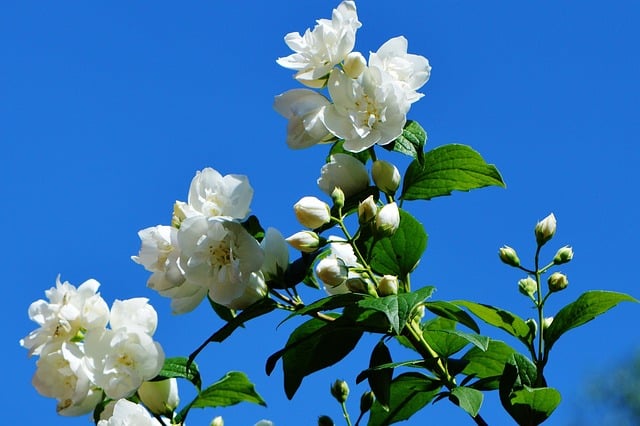Jasmine plants are a popular choice for gardeners due to their fragrant flowers and attractive foliage. However, even with proper care, these plants can sometimes begin to show signs of distress and may even die.
Recognizing the symptoms of jasmine plant dying and understanding the causes of these problems is essential for reviving the plant and preventing future issues.
Symptoms of a dying jasmine plant can include yellowing leaves, leaf drop, and wilting. These symptoms can be caused by a variety of factors, including overwatering, underwatering, nutrient deficiencies, pests, and diseases.
Understanding the specific cause of the problem is important for determining the appropriate course of action to revive the plant.
If a jasmine plant is dying, there are several steps that can be taken to try to save it. These may include adjusting watering habits, fertilizing the plant, pruning away dead or damaged branches, and treating any pests or diseases that may be present.
With proper care, it may be possible to revive a dying jasmine plant and restore it to its former beauty.
Key Takeaways
- Recognizing the symptoms of a dying jasmine plant is important for determining the appropriate course of action to revive the plant.
- Understanding the causes of jasmine plant problems, such as overwatering or nutrient deficiencies, can help prevent future issues.
- Reviving a dying jasmine plant may involve adjusting watering habits, fertilizing the plant, pruning away dead or damaged branches, and treating any pests or diseases that may be present.
Similar posts:
Recognizing Symptoms of a Dying Jasmine Plant

Jasmine plants are known for their fragrant flowers and lush green leaves. However, if you notice your jasmine plant is looking unhealthy, it may be dying. Here are some symptoms to look out for:
1. Yellowing Leaves
Yellowing leaves are a common sign of a dying jasmine plant. If the leaves are turning yellow and falling off, it may be due to overwatering or underwatering. Check the soil moisture level and adjust watering accordingly. Jasmine plants prefer moist, well-draining soil.
2. Wilting Stems
If the stems of your jasmine plant are wilting, it may be a sign of root rot. This can be caused by overwatering or poor drainage. Check the soil for moisture and make sure the pot has drainage holes. If the roots are mushy and brown, it may be too late to save the plant.
3. Falling Flowers
If the flowers on your jasmine plant are falling off before they have a chance to bloom, it may be due to stress. Stress can be caused by a lack of nutrients or too much sun exposure. Make sure your plant is getting enough fertilizer and is not in direct sunlight for extended periods.
4. Black Mold
Black mold on the leaves of your jasmine plant is a sign of a fungal infection. This can be caused by overwatering or poor air circulation. Remove the affected leaves and treat the plant with a fungicide.
5. Curling Leaves
Curling leaves on your jasmine plant can be a sign of insect infestation. Check the leaves for small bugs or spiderwebs. Treat the plant with an insecticide to get rid of the pests.
Jasmine Plant Dying – 5 Common Problems

Jasmine plants are known for their fragrant blooms and are a popular choice for gardeners and indoor plant enthusiasts alike. However, these plants can sometimes encounter problems that cause them to wilt, turn yellow, or even die. Understanding the causes of these problems is crucial for maintaining healthy jasmine plants.
1. Overwatering
Overwatering is a common cause of jasmine plant problems. When the soil is constantly wet, it can lead to root rot, which prevents the plant from absorbing nutrients and water effectively.
Symptoms of overwatering include yellowing leaves, wilting, and a foul odor emanating from the soil. To avoid overwatering, make sure to let the soil dry out between waterings and avoid allowing the plant to sit in standing water.
2. Underwatering
On the other hand, underwatering can also cause problems for jasmine plants. When the soil is too dry, it can cause the leaves to wilt and turn brown. In severe cases, the plant may drop its leaves and eventually die. To avoid underwatering, make sure to water the plant regularly and monitor the soil moisture levels.
3. Temperature Extremes
Jasmine plants prefer warm temperatures and can be sensitive to extreme heat or cold. Exposure to temperatures outside of their preferred range can cause the leaves to wilt or turn yellow.
In some cases, it can even cause the plant to drop its leaves or die. To avoid temperature extremes, make sure to keep the plant in a location with consistent temperatures and avoid exposing it to direct sunlight or drafts.
4. Nutrient Deficiencies
Jasmine plants require a balanced mix of nutrients to thrive. A lack of essential nutrients such as nitrogen, phosphorus, and potassium can cause the plant to grow slowly, produce fewer blooms, and become more susceptible to pests and diseases.
To avoid nutrient deficiencies, make sure to fertilize the plant regularly with a balanced fertilizer.
5. Pest Infestation
Jasmine plants can be vulnerable to a variety of pests, including mites, spider mites, and aphids. These pests can cause damage to the leaves and stems, leading to yellowing, wilting, and stunted growth.
To avoid pest infestations, make sure to inspect the plant regularly for signs of pests and treat them promptly with an appropriate pesticide or insecticidal soap.
By understanding the causes of jasmine plant problems, gardeners and indoor plant enthusiasts can take steps to prevent them and keep their plants healthy and thriving.
Reviving a Dying Jasmine Plant

Jasmine plants are known for their fragrant flowers and glossy green leaves, but they can be susceptible to various issues that can cause them to die. Luckily, there are several steps you can take to revive a dying jasmine plant and bring it back to its former glory.
1. Adjusting Watering Schedule
One of the most common reasons for a dying jasmine plant is overwatering or underwatering. Jasmine plants prefer moist soil, but not waterlogged soil.
To adjust the watering schedule, feel the surface of the soil under the jasmine plant to see if it is dry to the touch. If it is, it’s time to water the plant. If it is still moist, wait a few more days before watering again.
2. Modifying Temperature Conditions
Jasmine plants thrive in warm temperatures, but extreme heat or cold can cause them to die. If the jasmine plant is exposed to direct sunlight for an extended period, it can cause the leaves to burn and wilt.
On the other hand, if the plant is exposed to freezing temperatures, it can cause the leaves to fall off. To modify temperature conditions, move the plant to a shaded area if it’s too hot or to a warmer area if it’s too cold.
3. Addressing Nutrient Deficiencies
Nutrient deficiencies can cause a jasmine plant to die. Jasmine plants require high levels of potassium and phosphorus to thrive. If you notice that the leaves are turning yellow and the flowers are falling off, it might be a sign of a nutrient deficiency.
To address nutrient deficiencies, try to implement fertilizer that contains high levels of potassium and phosphorus into the plant’s diet. You can also add chelated iron to the soil to address iron deficiency.
4. Treating Pest Infestation
Pests like spider mites and aphids can infest a jasmine plant and cause it to die. Spider mites are tiny pests that can cause the leaves to turn yellow and fall off. Aphids are small insects that suck the sap from the plant and cause the leaves to curl.
To treat pest infestation, spray the plant with insecticidal soap or neem oil. You can also use a homemade solution of water and dish soap to kill the pests.
By following these steps, you can revive a dying jasmine plant and bring it back to life. Remember to adjust the watering schedule, modify temperature conditions, address nutrient deficiencies, and treat pest infestation. With a little bit of effort and care, your jasmine plant will thrive and bloom beautifully.
Preventing Future Jasmine Plant Problems

To prevent future issues with jasmine plants, it’s important to take proper care of them. This includes selecting the right soil, providing appropriate sunlight exposure, regular pruning, and timely repotting.
1. Proper Soil Selection
Jasmine plants require well-draining soil that is rich in nutrients. When selecting soil, it’s important to choose a high-quality potting mix that contains organic matter such as peat moss or compost. The soil should also have a pH level between 6.0 and 7.5. If the soil is too acidic or alkaline, it can cause nutrient deficiencies in the plant.
2. Appropriate Sunlight Exposure
Jasmine plants require full sun to thrive. When growing jasmine indoors, it’s important to place the plant in a location that receives at least 6 hours of sunlight per day. If growing jasmine outdoors, it’s important to choose a location that receives full sun for most of the day.
3. Regular Pruning
Regular pruning is essential for jasmine plants to maintain their shape and promote healthy growth. This includes removing dead or damaged branches, as well as trimming back any overgrown branches. Pruning should be done in the spring after flowering has finished.
4. Timely Repotting
Jasmine plants should be repotted every 2-3 years to ensure they have enough space to grow and receive fresh potting soil. When repotting, it’s important to choose a pot that is slightly larger than the current one. The new pot should also contain fresh potting soil that is rich in nutrients.
By following these guidelines, gardeners can help prevent future issues with their jasmine plants. Proper soil selection, appropriate sunlight exposure, regular pruning, and timely repotting can all help promote healthy growth and prevent problems such as yellowing leaves or wilting.
Additional Care Tips for Healthy Jasmine Plants

1. Maintaining Humidity Levels
Jasmine plants thrive in humid environments, so it’s important to maintain the right humidity levels. To increase humidity, place a tray of water near the plant or use a humidifier. Alternatively, misting the plant with water once or twice a day can also help maintain humidity levels.
2. Using Frost Blankets
Jasmine plants are sensitive to frost and freezing temperatures, which can cause damage and even kill the plant. To protect the plant from frost, use a frost blanket or cover the plant with a cloth or tarp. Be sure to remove the cover during the day to allow sunlight and air to reach the plant.
3. Applying Mulch
Mulching around the base of the jasmine plant can help retain moisture in the soil and regulate soil temperatures. Use organic mulch such as bark, straw, or leaves, and apply a layer of 2-3 inches thick. Be sure to keep the mulch away from the base of the plant to prevent rot.
4. Choosing the Right Pot
If growing jasmine in a pot, choose a pot that is large enough to accommodate the plant’s roots and has good drainage. Use a well-draining potting mix that is rich in organic matter. Avoid overwatering and allow the soil to dry out slightly between waterings.
By following these additional care tips, jasmine plants can thrive and remain healthy.
Frequently Asked Questions

How to revive a dying jasmine plant?
If your jasmine plant is dying, there are a few things you can do to revive it. First, make sure the plant is getting enough water. If it is not, water it more frequently.
If your jasmine plant is in a pot, repot it into fresh soil. If it is in the ground, make sure the soil is not too sandy and retains enough moisture. You can also fertilize your jasmine plant with nutrients high in potassium and phosphorus.
Why is my jasmine going brown?
If your jasmine plant is turning brown, it may be due to overwatering or underwatering. Check the soil to see if it is too moist or too dry. If it is too moist, stop watering the plant until the soil dries out.
If it is too dry, water the plant more frequently. Brown leaves can also be a sign of a fungal infection or pest infestation.
What is killing my jasmine?
There are several things that can kill a jasmine plant, including overwatering, underwatering, fungal infections, pest infestations, and root rot. If your jasmine plant is dying, it is important to identify the cause of the problem so that you can take the appropriate steps to save it.
How do you revive a dead jasmine plant?
Reviving a dead jasmine plant can be difficult, but it is possible in some cases. First, remove any dead or diseased parts of the plant. Then, repot the plant into fresh soil and water it regularly. You can also fertilize the plant with nutrients high in potassium and phosphorus to help it recover.
Why are my jasmine leaves turning brown and crispy?
Jasmine leaves can turn brown and crispy due to a lack of water, too much sun exposure, or pests such as spider mites or mealybugs.
Check the soil to make sure it is moist enough, and move the plant to a shadier location if it is getting too much sun. If pests are the problem, treat the plant with an insecticide.
Why has my jasmine plant lost all its leaves?
If your jasmine plant has lost all its leaves, it may be due to a fungal infection or pest infestation. Check the plant for signs of pests, such as spider mites or mealybugs, and treat it with an insecticide if necessary.
If a fungal infection is the problem, remove any affected parts of the plant and treat it with a fungicide.

Hey, I’m Lisa and I’ve been an avid gardener for over 30 years. I love writing, talking and living in the garden! Feel free to connect with me on my socials below


